Published on 1st June 2022
Seed & Establishment
The National Winter OSR Management Study - 2022

Bayer’s annual series of Dekalb benchmarking studies shows a further improvement in crop condition and performance expectations this season; identifies the key management techniques being employed to reduce overall OSR risk
The National Winter OSR Management Study - 2022
Summary
The third in Bayer’s annual series of Dekalb benchmarking studies shows a further improvement in crop condition and performance expectations this season; identifies the key management techniques being employed to reduce overall OSR risk; and reveals a marked increase in planting intentions for the coming year.
A similarly large number of growers, extensive crop area and spread of crops across the country to the 2020 and 2021 studies allows useful comparisons over the three seasons.
Drill Timing & Variety Type
The swing to earlier drilling evident from 2020 continued. Over half the growers
sowed the bulk of their crops on or before August 20 last autumn compared to less than a third in the 2019/20 study, with mid-August now by far the most popular sowing slot.
A marked shift towards hybrid-growing was also evident in the response. Almost half the crops planted in autumn 2021 were mainstream double low hybrids and only around a third conventionally-bred pure lines. This compares with around a third hybrids and more than half pure lines in both 2020 and 2019.
CSFB Challenge & Crop Survival
For the second year in a row, far fewer growers reported their crops suffering a significant autumn challenge from CSFB, with 90% seeing a less than substantial challenge and half virtually no challenge at all.
As in previous years, the level of pest pressure varied with drilling date – the earliest drillings seeing the least CSFB challenge and the later ones the greatest.
Lower CSFB pressures combined with good establishment conditions and a growthy early winter led to an even higher percentage of the crops drilled (92%) being taken through to harvest than last season, itself much improved on 2019/2020.
Particularly welcome improvements in crop survival over 2020/21 were evident in the West Midlands & Wales and South. Crop survival from the earliest and latest drilling dates was also noticeably better than last season.
For the third year running a higher proportion of hybrids than conventional pure line varieties were taken through to harvest.
Establishment Success
Despite slightly higher crop survival rates overall, average establishment success rated by growers was a little lower than last season. Reflecting lower overall CSFB pressures, however, this seems to have been more than offset in crop survival terms by lower year-on-year spring larval levels.
Underlining the critical importance of the best OSR establishment, a very close relationship was evident between crop establishment score and the proportion of crops being taken to harvest.
Similarly close relationships were evident between CSFB pressures at establishment and both crop establishment score and the proportion of crops being taken to harvest.
Even though average establishment scores were slightly lower than last year, 60% of growers considered their 2021 establishment to have been better than 2020 with only 12% believing it to have been worse.
Particular year-on-year establishment improvements were evident in the North & Scotland; in the earliest-sown crops; and, among hybrid varieties.
Insecticide Use & Development to Spring
Encouragingly, just over a third of growers deliberately avoided using an insecticide spray last autumn to encourage predators. Of those not deliberately avoiding autumn insecticide use, just over a third didn’t need to spray while only 14% needed to spray more than once.
Generally good establishment and favourable winter conditions meant most crops went into the spring with encouragingly good Green Area Indexes.
Worryingly, however, the proportion of crops with mid-February GAIs of over 2.5 reported from early August sowings was almost 50%. This could easily compromise their performance.
Past Performance & Current Expectations
The study growers brought-in yields averaging 3.02 t/ha in 2021. Based on the condition of their crops going into flowering, almost two thirds of them expect to see a better performance this season.
Improved performance expectations are especially high among those in the North & Scotland, West Midland & Wales and the South; those drilling their crops either relatively early or relatively late; and hybrid growers.
Risk Reduction Techniques
Nine techniques stood out as being used by half or more of growers to minimise their OSR growing risks, of which eight relate to management up to and at establishment. While combatting CSFB is clearly important here, tackling the traditional crop pests of slugs and pigeons continues to be a priority for most.
A further nine techniques are being used by more than a third but less than half of growers. Again,the majority of these relate to decisions up to and at establishment.
Thankfully, among the dozen other techniques only used by a minority of growers are traditional approaches like increasing seed rates, using farm saved seed and spraying insecticides to support establishment that have generally been found wanting.
Ten of the 18 reasonably widely-used crop risk management techniques stand out for their particular perceived effectiveness, with scores of 7.5 or more on a 0-10 scale.
Interestingly, these include all three variety-based techniques – employing pod shatter-resistance; choosing vigorous fast-developing hybrids; and, prioritising varieties with all-round agronomic strength.
Current Planting Intentions
More than half the growers intend to increase their OSR plantings in the 2022/23 season, with only around a quarter considering a reduction in the crop.
Altogether, they plan to plant more than 14,250 ha of OSR this autumn against around 12,250 ha currently being grown – a year-on-year area increase of just over 16%.
While the bulk of growers in every region plan to increase their OSR plantings for 2022/23, a noticeably greater increase in planting intentions is evident among those in the West Midlands & Wales and the South.
The earliest drillers are clearly more positive in their planting intentions, and those sowing the bulk of their current crop in mid-August noticeably less so, suggesting a continued trend towards the earliest drillings.
A somewhat greater proportion of hybrid growers are planning to increase their plantings for harvest 2023 than those growing mainly pure line varieties. Particularly marked in area terms, this suggests a further swing towards hybrids.
Not unexpectedly, planting intentions for 2022/23 appear to be heavily influenced by current crop expectations. Almost 60% of those expecting their crop to perform better than last year are planning to increase their OSR area with an almost identical proportion of those expecting a worse year-on-year crop performance planning to reduce their plantings.
BackgroundMoving on from two years of oilseed rape studies centred on managing Cabbage Stem Flea Beetle, this year’s Bayer study conducted digitally at the same spring timing was designed to capture wider information about crop condition and management. It also builds on responses to a shorter establishment poll undertaken in the early winter.
A number of identical core questions to the previous two years were included to enable key aspects of crop establishment and condition to be compared and contrasted over the three most recent seasons.
At the same time, extra questions have broadened the study to explore the extent to which growers are employing a whole host of management techniques to reduce their OSR production risk and how successful these are proving.
The Sample
Responses were analysed from 173 respondents, growing around 270 separate crops of winter OSR across more than 12,000 ha.
This was almost identical to previous study samples, enabling useful year-to-year comparisons.
The geographical spread of respondents across the main growing areas was also similarly good to the previous year (Figure 1).
Figure 1: Geographical Spread

Sowing Date
Confirming the trend seen in the 2021 establishment poll, a continued swing to earlier drilling was evident again this season. Over half the growers sowed the bulk of their crops on or before Aug 20 compared to less than a third in the 2019/20 study. Noticeably fewer growers than last year sowed the bulk of their crops in September with the biggest year-on-year increase in the August 8-20 slot. (Figure 2).
Figure 2: Sowing Date (2019/20 – 2021/22)

There was considerable regional variation in the timing of sowing, with over 70% of East Midlands and Eastern growers sowing the bulk of their crops on or before August 20. In contrast, half of those in the West Midlands & Wales concentrated on September sowing.
Variety Types
A marked shift towards hybrid growing was evident in the responses, with almost half the crops in the 2021/22 ground being mainstream double low hybrids and only around a third conventionally-bred pure lines.
The proportion of specialist hybrids was also noticeably higher than the previous year (Figure 3). This was mainly due to an increase in clubroot resistant variety plantings_._
Figure 3: Main Variety Types (2019/20 – 2021/22)
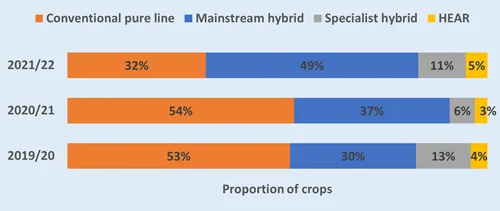
Autumn CSFB Challenge
For the second year in a row, far fewer growers reported their crops suffering a significant autumn challenge from CSFB in 2021, with 90% seeing a less than substantial challenge and half virtually no challenge at all.
This was a noticeable improvement on the previous autumn and in marked contrast to 2019 when over half of crops faced a particular challenge from the pest (Figure 4).
Figure 4: Level of Autumn CSFB Challenge (2019/20 - 2021/22)

As in previous years, the level of challenge clearly varied with drilling date, with the earliest drillings seeing the least pest challenge and the later ones the greatest (Figure 5).
Like 2020/21, though, the differences in pest pressure between the drilling slots were far less obvious than in the more challenging 2019/2020 season.
With the possible exception of mid-August, which saw a slight apparent year-on-year increase, less adult CSFB pressure than 2020 was reported in most drilling slots.
Figure 5: Level of Autumn CSFB Challenge by Drilling Date (2021/22)

Once again, the level of CSFB pressure varied across the country. The North & Scotland and East Midlands were joined by those in the South in experiencing rather less of a challenge from the pest than the previously, while growers in the Eastern Counties continued to see somewhat higher levels of pressure.
Crop Survival
At 92% on average, lower CSFB pressures combined with good establishment conditions and a growthy early winter resulted in an even higher percentage of the crops drilled being taken through to harvest than last season, itself much improved on 2019/2020 (Figure 6).
Figure 6: Overall Crop Survival (2019/20 to 2021/22)

All parts of the country are taking 90% or more of the crops drilled to harvest this season.
While these levels were quite similar to last season in most regions, particularly noticeable improvements in crop survival over 2020/21 were evident in the West Midlands & Wales and South (Figure 7).
Figure 7: Crop Survival by Region (2019/20 vs 2021/22)

Overall crop survival from the earliest and latest drilling dates was noticeably better than last season with a suggestion of improvement from late August sowing too. Although remaining at a very healthy 90%, in line with somewhat higher CSFB pressures in mid-August sowings compared to 2020/21, crop survival from this slot looks to have declined slightly year-on-year (Figure 8).
Figure 8: Crop Survival by Drilling Date (2019/20 to 2021/22)

For the third year running, a higher proportion of hybrids than conventional pure line varieties were taken through to harvest. The more favourable establishment conditions again meant a much smaller gap between variety types – at 93% to 91% taken to harvest – than in the challenging conditions of 2019/20 (Figure 9).
Figure 9: Crop Survival by Variety Type (2019/20 to 2021/22)

While there was little detectable difference between survival rates from sowings up to August 20, fully 97% of hybrids sown after this date were taken through to harvest compared to 89% of conventional pure line varieties. This underlines the particular value of hybrids for the second half of the drilling window when establishment challenges tend to be at their greatest.
Crop Success
Despite slightly higher crop survival rates, establishment success rated by growers on a 0-10 scale was slightly lower than last season at an average of 7.4 against 7.9.
Reflecting the lower overall CSFB pressures, however, this seems to have been more than offset in crop survival terms by rather lower year-on-year spring larval levels – at an average score of 2.8 on a similar scale (Figure 10).
Figure 10: Crop Success Scores (2019/20 to 2021/22)

* Crop Establishment (0= crop lost: 10 = perfect establishment) Larval Level (0= no larvae or scar: 10 = more than 30 larvae/plant or multiple scars on all petioles & stems)
Average establishment scores ranged from 6.8 in the East Midlands to 7.8 in the North & Scotland, with spring larval scores the highest in the Eastern Counties and the lowest in the North & Scotland.
Both early August and September plantings were reported to have establishment slightly better than mid- and late-August sowings although there was no obvious trend in spring larval levels with drilling date.
Although noticeably less than crops suffering more significant CSFB pressures at establishment, average spring larval scores of 2.2 for those judged to have seen little or no pressure suggests the impact of even apparently low adult infestations should not be under-estimated.
Hybrid crops had generally higher establishment scores at 7.8 than pure line varieties at 7.0.
They also had noticeably lower spring larval scores at 2.7 compared to 3.3.
What’s more, the difference in larval scores between hybrids at 3.3 and pure line varieties at 4.2 was even more noticeable where autumn CSFB pressures were significant (Figure 11).
Figure 11: Spring Larval Scores by Variety Type (2021/22)

* 0= no larvae or scar: 10 = more than 30 larvae/plant or multiple scars on all petioles & stems
Underlining the critical importance of the best OSR establishment, there was a very close relationship between crop establishment score and the proportion of crops being taken to harvest; especially so where establishment scores fell below the half-way mark (Figure 12).
Figure 12: Crop Survival by Establishment Score (2021/22)
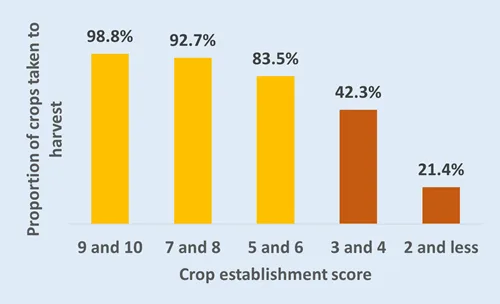
The significance of cabbage stem flea beetle in this is underlined by similarly close relationships between CSFB pressures at establishment and both crop establishment score (Figure 13) and the proportion of crops being taken to harvest (Figure 14).
Figure 13: Crop Establishment by CSFB Pressure (2021/22)

* 0= crop lost: 10 = perfect establishment
Figure 14: Crop Survival by CSFB Pressure (2021/22)

Relative Establishment Success
Even though average establishment scores were slightly lower than last year, 60% of growers considered their 2021 crop establishment to have been better than 2020, with just 12% believing it to have been worse (Figure 15).
Figure 15: Crop Establishment (2021/22 vs 2020/21)

Half or more growers in every region rated their crop establishment as better than the previous year, with those in the North & Scotland seeing the greatest improvement and those in the East and East Midlands the least (Figure 16).
Figure 16: Relative Crop Establishment by Region (2021/22 vs 2020/21)

Growers sowing the bulk of their crops the earliest generally saw the best year-on-year establishment improvement (Figure 17).
Despite issues for some, establishment from mid-August sowings was generally seen to be better too, as it was for those sowing the bulk of their crops September. Late August sowings were, however, the least good establishment-wise compared to the previous season.
Figure 17: Relative Crop Establishment by Sowing Date (2021/22 vs 2020/21)
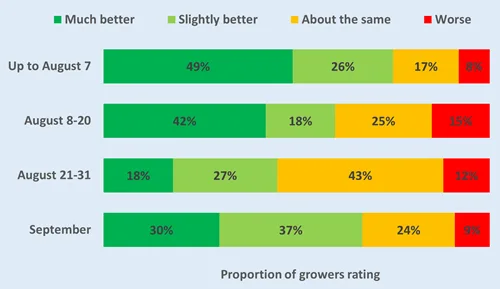
Hybrid growers saw slightly greater year-on-year improvements in crop establishment than those growing pure line varieties (Figure 18).
Figure 18: Relative Crop Establishment by Variety Type (2021/22 vs 2020/21)

Insecticide Use
Encouragingly, just over a third of growers deliberately avoided using an insecticide spray last autumn to encourage predators (Figure 19). This varied from a high of 50% of growers in the West Midlands and Wales to only 26% in the North & Scotland.
Figure 19: Insecticide Use Avoidance (2021/22)
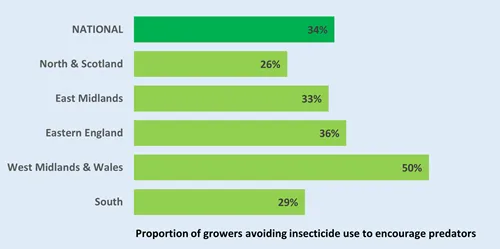
Of those not deliberately avoiding autumn insecticide use, just over a third didn’t need to spray in 2021 while only 14% needed to spray more than once.
These proportions varied quite widely by region, with more growers in Eastern England (where CSFB pressures were noticeably higher) both needing to spray and needing to spray more than once (Figure 20).
Although more East Midlands growers than average also needed to spray more than once, a markedly higher proportion than average didn’t need to spray at all.
Figure 20: Insecticide Use by Region (2021/22)
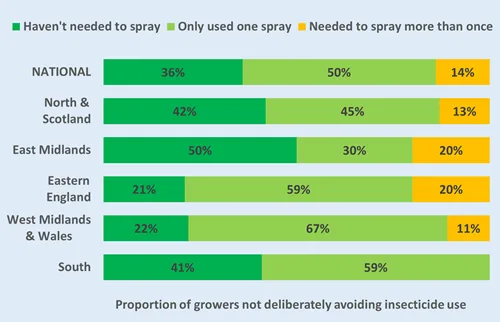
Unsurprisingly, the level of insecticide spraying was clearly related to the level of CSFB challenge, with well over half those growers seeing little or no pressure not spraying at all and none spraying twice (Figure 21).
In contrast, while around 20% of those seeing a significant CSFB challenge didn’t feel the need to spray, over half did so once and almost a quarter more than once.
Figure 21: Insecticide Use by Adult CSFB Pressure (2021/22)

Crop Development to Spring
Generally good establishment and a growthy early winter meant most crops went into the spring with encouragingly good Green Area Indexes.
Around 20% had GAIs of 1.0 or less in mid-February, though, while just over a quarter were particularly well-grown with indexes of 2.5 or more (Figure 22).
Figure 22: Approximate Mid-February Crop Green Area Indexes (2021/22)

While this was fairly consistent across the main planting window, the proportion of crops with GAIs of over 2.5 reported from early August sowings was almost 50%, with nearly 10% at 3.5 or more.
Although this may have offered valuable nitrogen economies, at anything other than the lowest sowing ratings, such large early canopies are likely to have compromised productivity, as well as presenting significant spring management challenges.
Anticipated Crop Performance
The study growers brought-in yields ranging from zero to 5.5t/ha last harvest, with an overall average of 3.02 t/ha.
Based on the condition of their crops going into flowering, almost two thirds of them expect to see a better performance this season, with just over a quarter anticipating similar yields to 2021 and only 10% reckoning they are likely to be worse (Figure 23).
While the greatest anticipated performance improvements clearly come from those seeing the most disappointing 2021 performance, nearly 40% of those recording averages of over 4t/ha last year also expect to see improvements this year.
Despite the notorious unreliability of early season OSR yield estimates, this level of optimism says a lot for the condition in which this year’s crops went into flowering.
Figure 23: Anticipated 2022 Crop Performance by 2021 Yield Group
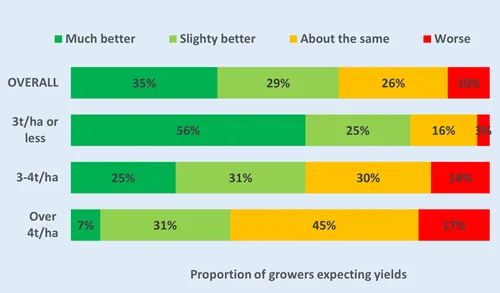
Growers in all regions appear relatively positive about their crop prospects this season, with rather more of those in the North & Scotland, West Midland & Wales and the South expecting some performance improvement (Figure 24).
Figure 24: Anticipated 2022 Crop Performance by Region
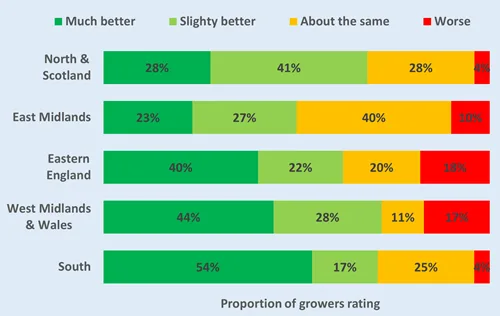
Hybrid growers also appear to be generally more positive about their crop performance relative to last season than those growing pure line varieties (Figure 25).
Figure 25: Anticipated 2022 Crop Performance by Variety Type

In line with all the other indicators, those drilling their crops either relatively early or relatively late appear to be more positive about improved performance at harvest than those sowing in either mid or late-August (Figure 26).
Figure 26: Anticipated 2022 Crop Performance by Drilling Date

Key Risk Management Techniques
Nine techniques stood out as being used by half or more of growers to minimise their OSR growing risks, of which eight relate to management up to and at establishment (Figure 27).
While combatting CSFB is clearly important here, tackling the traditional crop pests of slugs and pigeons continues to be a priority for most. Revealingly too – but not surprising given the clear relationship between establishment success and crop survival – getting the crop off to the best possible start is the focus of almost all the widely-used techniques.
Figure 27: Most Widely Used Risk Management Techniques (2021/2022)
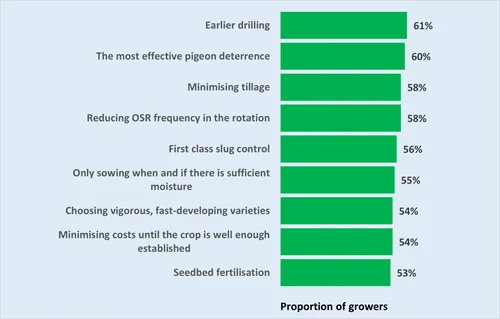
A further nine techniques are being used by more than a third but less than half of growers (Figure 28). Again,the majority ofthese relate to decisions before and at establishment.
Figure 28: Fairly Widely Used Risk Management Techniques (2021/2022)

A dozen other techniques are only being used by a minority of growers (Figure 29). Encouragingly here, traditional approaches like increasing seed rates, using farm saved seed and spraying insecticides to support establishment are now only being employed by less than a quarter of growers.
Figure 29: Less Widely Used Risk Management Techniques (2021/2022)

Ten of the reasonably widely-used risk management techniques stand out for their perceived effectiveness, with scores of 7.5 or more on a 0-10 scale (Figure 30). These include all three variety-based techniques.
Figure 30: Effectiveness of Risk Management Techniques (2021/2022)

* (0= not effective: 10 = highly effective)
Future Cropping Plans
More than half the growers surveyed intend to increase their OSR plantings in the 2022/23 season, with only around a quarter considering a reduction in the crop (Figure 31).
Figure 31: Planting Intentions for 2022/23
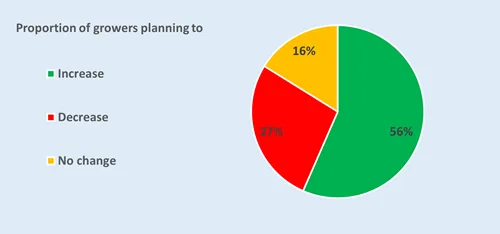
The growers plan on planting a total of more than 14,250ha of OSR this autumn against around 12,250ha currently being grown – a year-on-year increase of just over 16% (Figure 32).
Figure 32: Planting Intentions for 2022/23

This change is made-up of an average increase of 31ha (+56%) by those planning to grow more OSR and an average decrease of 20ha (-26%) by those planning to grow less.
While the bulk of growers in every region with the possible exception of the North & Scotland plan to increase their OSR plantings for 2022/23, a noticeably greater increase in planting intentions is evident among those in the West Midlands & Wales and the South (Figure 33).
Figure 33: Planting Intentions for 2022/23 by Region

Growers across all the main planting dates also plan to increase their OSR area, with the earliest drillers noticeably more positive in their planting intentions and those sowing the bulk of their current crop in mid-August noticeably less so (Figure 34). This suggests a continued trend towards the earliest drillings.
Figure 34: Planting Intentions for 2022/23 by Sowing Date

A somewhat greater proportion of hybrid growers are planning to increase their plantings for harvest 2023 than those growing mainly pure line varieties (Figure 35).
This is more marked in area terms, hybrid growers planning a net increase of just over 1400ha against just over 400ha planned by pure line growers. Again, it suggests a continuing swing towards hybrid plantings in the autumn 2022 mix.
Figure 35: Planting Intentions for 2022/23 by Variety Type

As might be expected, planting intentions for 2022/23 appear to be heavily influenced by current crop expectations. Almost 60% of those expecting their crop to perform better than last year (based on its condition at flowering) are planning to increase their OSR area and an almost identical proportion of those expecting a worse year-on-year crop performance planning to reduce their plantings (Figure 36).
Figure 36: Planting Intentions for 2022/23 by Current Crop Expectations




